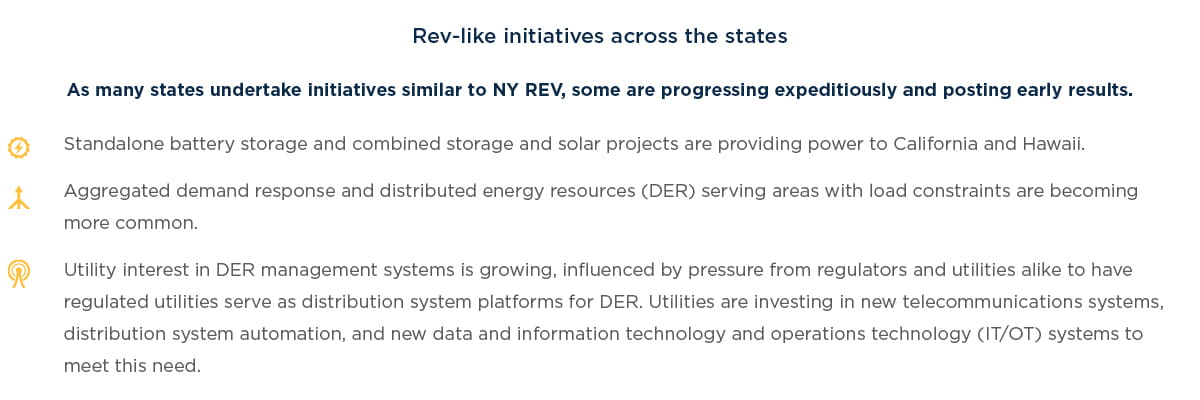
Archive | Point of View
Revisiting New York’s reforming the energy’s vision (REV)
Revisiting New York’s reforming the energy’s vision (REV)
In 2016, West Monroe examined the common assertion that REV is too broad and moving too fast. As many states are undertaking similar initiatives, some are progressing more expeditiously to promote REV-type objectives over others. We concluded at that time that the pace of REV was daunting, but the vision was unifying. The seemingly rapid pace and broad focus of the 16 or so related regulatory proceedings in New York were necessary to synchronize new technologies, innovations in utility operations, and utility business models. Now, however, the many and various proceedings, lack of significant progress to date, and the leadership vacuum at the Department of Public Service (DPS) and Public Service Commission (PSC) have many utility executives and participants in the proceedings wondering how this will all come together, and what will result.
Leveraging pilot success to push large-scale implementation
While REV is focusing on some necessary and complex issues, progress to date has been mixed at best. Pilot projects sponsored by utilities are moving ahead, yet the anticipated larger-scale rollout of the pilots is lacking.
The absence of tangible results can be attributed in part to the early stages of the pilots and insufficient rigor and study employed to determine and promote their success. Some argue that due to the uncertainty over costs of large- scale rollouts of the pilot projects, the PSC and many elected officials, as well as large customers, are reluctant to fully support moving from pilots to large-scale implementation.
In fairness, any push toward large-scale implementation of successful pilots should be justified based on the business case for implementation. The business case—demonstrating the economic, environmental, and social benefits of large-scale implementation— should be presented, debated, and approved through individual utility rate cases, and not through a general approach or combination of some of the 16 REV-related proceedings.
Customers both large and small should realize benefits of the REV-related initiatives with a positive net benefit. But to date, little information and data has been provided to make a compelling case for these initiatives. (On the other hand, it can be argued that cutting-edge innovations should be experimented with first, to gain experience with technology and innovations that would later inform the business case.)
Wanted: Clear rules of engagement
We continue to believe that the PSC has developed a well-designed framework to account for the many moving and interrelated parts of the industry’s transition to a consumer model. We also believe the time has come to consolidate proceedings (or discontinue some altogether) for relevant parties, and for the PSC to agree on the new regulatory paradigm with clear rules, expectations, and some combination of cost-of- service and incentive ratemaking.
Non-utility providers of electricity and other energy services, including demand response, storage, and renewable energy generation, need clear rules of engagement—they must be able to assess risks and generate profits with some certainty to proceed through this transition.
Assessing REV progress to date, it is essential that various aspects of REV need to be addressed.
We find that the vision and early framework for REV was well-designed. However, it must now evolve to prioritize, manage, and implement the many initiatives critical to creating the envisioned distributed system platform.
The PSC provided further structure and regulatory input through its March 9, 2017 order*, which requested additional documentation from the utilities including:
- Implementation status of Phase 1 of Interconnection Portals
- Plans for integrating suitability criteria
- Status or confirmation that energy storage projects are operating “at no fewer than two separate distribution substations or feeders”
- Hosting capacity analyses
- Filing re: building energy management and benchmarking data standards
When every project is an REV project
With almost every New York energy policy initiative advanced by Gov. Andrew Cuomo tagged as REV-related—from New York's green bank, to high voltage transmission system upgrades, to offshore wind—it is no wonder the REV moniker is being diluted. Working in many other states and with many large investor-owned utilities throughout the country, utility executives and intervenor groups are looking to states with demonstrable progress to emulate.
There is much confusion among stakeholders and across the country about exactly what is going on under REV. Regulatory proceedings and discussions are largely ignoring costs and assuming system operations, including reliability and resiliency, would not be negatively affected, and in fact would be improved with DER penetration and innovations in grid operations.
However, utility executives are hesitant to integrate large amounts of DERs into their systems until regulators clearly articulate the rules to guide the transition. Unless rules are clarified, utilities have little control over where DERs are placed unless they can own or operate such assets.
Most utilities do not currently have the software and operating systems to monitor and report on system output, which is important for maintaining voltage support and reliability. And to date, due to low levels of DER penetration, such systems have not been critical to system reliability. Rather than chaotically adding DERs to customer sites and utility systems, utilities, regulators, and third- party providers should collaborate to provide the overall greatest net benefit to customers. For example, certain pilot projects under REV set out to demonstrate how New York utilities are using innovative technology and renewable energy offerings. Optimal outcomes of these pilot projects include quick and cost-effective management of location-based demands.
So much has changed–already
The combination of utilities as last-resort providers, coupled with the obligation to serve, means that utilities need to maintain their financial viability and at the same time support customers’ and regulators’ interest in DERs and smart grid operations. To meet legal and regulatory obligations, utilities will continue to require cost recovery for services provided, and to maintain the transmission and distribution system infrastructure serving as the backbone to a distributed system platform. To expedite the industry’s transition, regulators need to define the new regulatory paradigm where the rules, as well as roles and responsibilities of utilities and non- utility providers, are clear. NY REV would benefit from revisiting its original plan and outline where it can go from here, given recent advances over the last year.
If DER adoption by customers and interconnection to the grid outpaces a utility’s ability to absorb and integrate them into the grid, business models, rate design, and the regulatory outfit need to be revisited—and quickly. Without regulatory change and certainty, we risk some of the negative repercussions described as the utility “death spiral:" rising electricity rates, possible customer erosion, and negative feedback.
In the months following that examination, a lot has happened in REV and much has changed at the DPS and PSC. Several senior staff at the department left, there has been some limited reorganization, and the PSC is down to two members from five. While the DPS is still active in the proceedings and PSC can still act, there is some understandable skepticism about how rapidly and fundamentally things will proceed.
Regulatory activities in other states seem to be steady and progressing. Recent legislation passed into law in Illinois, for example, portends a significant departure from the status quo: opening new business opportunities for utilities in DER, micro-grids, community solar, and rate design. California and Massachusetts are moving forward with storage initiatives, electrification of transportation, and grid modernization efforts that will alter the configuration of the grid.
Certainty must come from somewhere
It is incumbent upon utility regulators and state policymakers to provide a defined framework and some degree of certainty to the industry if REV and similar initiatives are to succeed. The utility industry remains capital intensive, requiring large amounts of capital to be invested in long-lived assets. Even customer-sited DER require large amounts of upfront capital or long-term leasing arrangements by customers whose lifetime benefits from such investments are equally as uncertain as regulatory changes. Uncertainty is the enemy of a sound and reasoned investment strategy. While the need for infrastructure investment grows, so does the uncertainty of a return on any given investment until such time that a regulatory paradigm is defined and the rules are clear. As regulatory and policy uncertainty increases, so does industry investment risk.
Identifying incentives to drive desired investment and market behaviors consistent with public policy goals for maintaining a reliable, resilient, and a dynamic grid is more important than ever. Infrastructure investments made today will define the grid for decades to come. While many noteworthy efforts are taking place at the federal and state level to guide investment decisions, utilities and third parties are reluctant to invest too much too soon without clear guidance from federal and state regulators. Whether this clarity is provided through individual rate cases or generic policy proceedings is less important than it being provided at all.
Utilities want assurance that their customer base will not erode and that cost recovery of prudent investments will be allowed over some reasonable period of time. Non-utility providers require similar assurances, either directly from customers or utilities, depending on who they are selling to. It is no easy feat to balance low rates with necessary investments, introduce new technologies to foster development of a 21st century grid, and support more non-utility participation in markets.
The business case for infrastructure investment
Grid modernization is defined as capital investment in physical infrastructure and IT/OT systems necessary to operate the grid, including customer and billing systems and revenue collection.
These investments are traditionally capitalized and recovered over their projected useful lives. Investing in transmission and distribution (T&D) infrastructure, including automated controls, sensors, and two-way communications, are of limited value without the IT/OT systems necessary to realize the full benefits.
Such investments by utility or non-utility providers requires the support of regulators. Driving regulatory support is the “business case”—the ability to demonstrate that any such investment has a defined payback. A positive business case implies that customers will be better off if the investment is made than they would be under the next best alternative investment. As states, regulators, and utilities contemplate what the “utility of the future” is, they must consider first and foremost the importance of maintaining a reliable and resilient electric system and how much customers and society are willing to pay for it.
It is not a question of whether technology exists today to enable a dynamic, robust and reliable and resilient grid, or whether competitive alternatives to transitional utility service exist. The question is: Who will lead grid modernization efforts and how much are regulators willing to have customers pay? Lastly, the issue of who invests (i.e., utilities or non- utility providers) and who controls the assets from an operational perspective is critical to address.
Conclusion
Promoting competition in a regulated market requires clear rules, well-defined regulatory oversight, and behavioral expectations for market participants. A fundamental principle of regulation is that the prices and services resulting from regulation will approximate those that would have been provided in a fully competitive market environment. If REV is to succeed, it must create an environment that not only harnesses the cost- effective DERs coming on the electric grid, but also one that accommodates utility expectations on IT/OT and grid modernization enhancements that affect its customer base. However, this “future- state” environment is struggling to connect with all stakeholders as the equal treatment of DERs and traditional generators currently conflicts.
The March 9 Order by the PSC brings REV stakeholders (utilities, customers, and energy developers) eight months closer to the ideal “future state.” While the provisional methodology begins to bridge the information gap, allowing DER investments to be compensated based on the value provided to the power grid, the current regulatory setting puts REV at a disadvantage as the definition of what “value” means to each stakeholder needs to be clearer.


